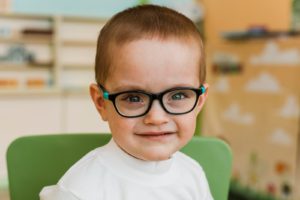Genetics only play a small part. Although a family history of myopia increases children’s risk of developing it, purely genetic cases of myopia are rare.
Lifestyle factors are considered more significant, particularly lack of time outdoors and concentrating on nearby objects for longer periods of time, such as while reading.
It is clear that education itself in the sense of discovering the world and empowering people with knowledge and techniques does not worsen eye health. In fact, education is linked to several positive and measurable effects on health.
But how children get their education in the modern world, with an emphasis on long hours spent in classrooms, seems to be consistently hurting their eye health.
What are the symptoms?
Myopia can be a disease with hidden signs, but some symptoms of childhood myopia can be noticed, such as:
• Difficulty in school learning: without being able to see from afar, the child does not follow lessons or classes correctly and may fall behind in learning.
• Frequent eye irritation: myopia can make the eyes irritated and red, in addition to blurring the vision, which causes the child to scratch his eyes frequently.
• Constant headache: squinting, frowning, and trying to concentrate as hard as you can are myopic habits that try to see straight. As children can do this for a long time, especially at school, they may experience headaches.
• Difficulty in playing: not being able to see from afar can get in the way when playing. Team sports, which may include graphic elements, throwing balls, can be especially difficult for children with this trait.
How to delay childhood myopia?
Myopia has no cure, but treatments are effective in controlling and improving the quality of life of those who have the disease. In the case of childhood myopia, some of them are even more important to stop the progression of the disease and prevent children from having more serious cases of the condition. Some of the main methods for this are:
• Atropine eye drops: Topical atropine is a medication used to dilate the pupil and is usually not used during routine eye exams because its long-lasting effect can take a week or more to wear off. To control childhood myopia, the use of atropine is combined to deactivate the eye’s focusing mechanism. The results are especially positive in the first year of treatment. On the other hand, it should be used with caution, because prolonged pupil dilation causes loss of ability to focus during treatment.
• Gas Permeable Contact Lenses (RGP): Gas permeable lenses are a high-quality lens made from a combination of plastic and silicone. They have a semi-flexible consistency and are smaller than the cornea. Its main advantage is that it has a tailored fit to the eye, enabling a clearer vision, especially in high degrees of childhood myopia.
• Multifocal glasses: this option is interesting because multifocal lenses for glasses combine degrees in a single item. With three fields of view, there is no visible separation between them, making a progressive transition from one to the other. Thus, you need to direct your gaze to the right point of the lens, depending on what you want to focus on.
• Undercorrection of myopia: Refractive surgery is done in some cases to correct childhood myopia and an undercorrection means correcting less than is really necessary. Thus, the procedure reduces the focus of ocular tension, which has been pointed out as one of the causes of the progression of myopia.
If you suspect that your child suffers from myopia, make an appointment with a specialist.


